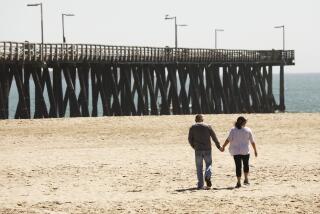Sewer excavation project is a subject of San Bruno explosion probe
Federal investigators are examining whether work on a sewer near a natural gas pipeline in San Bruno two years ago played a role in the explosion and fire that leveled part of the Bay Area suburb last week in one of the nation’s deadliest pipeline failures in nearly a generation.
When the city replaced the sewer line, it also enlarged its diameter and used a trenchless “pipe bursting” method known to carry risk. A 2001 study by the U.S. Army Corps of Engineers said the method could potentially disturb, displace and compact soils.
Pacific Gas & Electric Co., the pipeline owner, did not respond Wednesday to questions but previously told the San Jose Mercury News that it had inspected the gas line before and after the sewer construction.
Christopher Hart, vice chairman of the National Transportation Safety Board, which is leading the inquiry, said in an interview Wednesday that — although the investigation is still in its early stages and no conclusions have been reached — the sewer project is among the activities being scrutinized by investigators.
“One of the issues we’ll be looking at is whether excavation in the vicinity of the pipe may have caused damage to the pipe,” Hart said. “We’ll be looking at the entire history of the sewer line to see all the excavation.”
Hart stressed that multiple factors often contribute to catastrophic infrastructure failures. “There are typically many links in the chain that result in an event like this and I expect that will be the case here too,” he said.
When San Bruno replaced the sewer pipe west of the explosion site in 2008, it went from a 6-inch to a 10-inch diameter, records show. A year earlier, workers had replaced a section east of the explosion site. The work would have required excavations near the gas pipeline, and overhead photographs taken before the blast show patches in the pavement.
When the pipe bursting procedure damages nearby pipes, it usually occurs during the construction work, so the fact that two years passed before the San Bruno accident “diminishes the connection, but it doesn’t eliminate it,” said Raymond Sterling, co-author of the Army Corps report and one of the top U.S. experts on the technology.
“It is possible you can cause a local buckling in [a nearby] pipe and that over time causes extra corrosion that nobody notices,” he added.
The San Bruno blast killed at least four people; three more victims are missing and presumed dead. It also destroyed or severely damaged 56 homes, prompting the Obama administration on Wednesday to propose intensified pipeline safety oversight.
The fire damage was estimated at $65 million, according to state officials. Gov. Arnold Schwarzenegger on Wednesday requested federal disaster relief.
The proposal to Congress would more than double penalties for safety violations, require emergency flow-restricting devices in pipelines and expand the number of lines and areas covered by enhanced safety rules for pipes running through populated areas.
Records released Wednesday also showed that PG&E received approval in 2007 to spend $5 million of ratepayer money to replace a high-risk section of the 30-inch pipeline north of the San Bruno blast site, but never performed the work.
And this year, PG&E asked for another $5 million to do the same job, according to utility documents submitted to the state Public Utilities Commission.
In the recent request for capital expenditures, PG&E described the portion of the pipeline in South San Francisco, about 1.5 miles north of the segment that exploded, as ranking in “the top 100 highest risk line sections” in a 2007 evaluation.
That section of the line “has a potential impact radius of 415 feet and is located in a heavily urbanized area,” PG&E wrote. “If the replacement of the pipe does not occur, risks associated with this segment will not be reduced. Coupled with the consequences of failure of this section of pipeline, the likelihood of a failure makes the risk of a failure at this location unacceptably high.”
Mark Toney, executive director of the Utility Reform Network, which released the utility documents, said, “There’s no excuse for deferring maintenance of potentially compromised pipelines that run under customers’ homes, businesses and schools.” Toney’s group monitors electric and gas company regulatory activity in the Bay Area.
After testing the pipe corrosion in 2009, PG&E officials say, the company decided to reschedule the project.
PG&E has the discretion to reprioritize its pipeline replacement projects, said Cheryl Cox, a policy adviser for the Public Utility Commission’s Division of Ratepayer Advocates. She stressed, however, that PUC investigators would be looking at all aspects of the pipeline’s history and programmed maintenance.
U.S. Rep. Jackie Speier, a Democrat who represents San Bruno, said she wants to know why the commission didn’t question PG&E about the original $5-million capital expenditure to fix the high-risk pipeline section north of San Bruno.
“At some point don’t you have to ask them what they used the money for?” Speier said, adding that she’s concerned regulators may have been “foot-dragging” on ordering improvements in pipeline safety.
The close examination of the sewer line construction project is understandable because, according to federal records, excavation has been a leading cause of significant gas transmission line failures over the last two decades. More than 1 in 5 such incidents was caused by excavation, a slightly lower proportion than failures of materials, welds and equipment.
In the San Bruno case, the proximity of the junction between the sewer and gas lines and the center of the explosion should be an obvious factor in the investigation, said Brigham A. McCown, former chief of the federal Pipeline and Hazardous Materials Safety Administration.
“Absolutely you would want to take a close look,” McCown said. “Anything near or adjacent to the existing line could have an impact.”
McCown said improperly documented records of underground pipes and other location errors often play a key role in accidents. “Even if the work on the sewer were 15 or 20 feet away, one of the factors the NTSB will be looking at is the extent of the work and the locations.”
Pipe bursting, a procedure widely used around the world, involves pulling a cone-shaped bursting head through an older pipe with a cable and winch. But the projects require careful planning and engineering to avoid damaging adjacent underground utilities, said Sterling, the pipe-bursting expert.
The process can cause ground movements that potentially can bend other nearby pipes, he said. The potential for damage depends on many factors, including the soil type and water content.
The 2008 sewer work involved replacing 1,600 feet of the line along Earl Avenue that was causing sewage overflows during rain storms, according to a presentation to the San Bruno City Council by Deputy Public Works Director Steven Davis.
Davis, who has since left the city, said officials believed the old sewer had an 8-inch diameter, but in the course of other work found it was only 6 inches and causing a bottleneck in the system. The city amended an earlier contract with the San Francisco construction firm D’Arcy & Harty to perform the pipe-bursting work.
The company said PG&E had inspected its gas line and found no problems after the sewer work. It also asserted that “the city of San Bruno has stated the sewer replacement project was not a factor in the pipeline explosion.” D’Arcy & Harty said it “will cooperate with the ongoing investigations.”
Davis said at the time that the city needed to resolve the problem before the next rainstorm hit. The contract was amended with little discussion.
“I don’t believe there would be a direct connection” between the sewer work and the gas explosion, Davis said in an interview Wednesday.
Times staff writers Rich Connell and Maria L. La Ganga contributed to this report. Vartabedian and Connell reported from Los Angeles; Hoeffel and La Ganga from San Bruno; and Lifsher from Sacramento.
More to Read
Sign up for Essential California
The most important California stories and recommendations in your inbox every morning.
You may occasionally receive promotional content from the Los Angeles Times.











